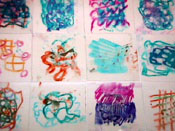
Overhead transparency quilt.
Create a miniature design and project it on a screen to explore TEXTURE
like never before.
Materials:
· Acetate (cut into 2"x2" squares)
· Non-toxic felt markers (with points of different sizes)
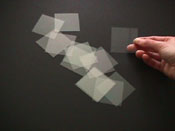 Directions: Directions:
1. Use felt-tipped markers or the India ink with the paintbrushes to draw
or paint on the acetate squares. Make as many different lines as you can
imagine.
2. Try another square but this time, fill in the whole 2"x2" piece of
acetate with one solid colour and then press your thumb on the square.
You should be able to see your thumb print if you look closely. This is
messy work so be sure your markers are non-toxic and wash off easily.
3. After you have completed at least 16 designs, tape the acetate together
to form an 8"x8" square.
4. Place on the overhead projector and prepare yourself for a spectacular
work of textured art. Do this activity with a friend or with your class
to mix and match squares to form a larger quilted pattern. Exhibit your
overhead transparency quilt in a window after you view it on the overhead
projector.
Monoprinting
Unlike other forms of printing that Christopher Pratt practices (etching
and lithography) monoprinting is a means of producing a single print of
an image. There is no complicated process involved and little equipment
is required.
Materials: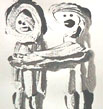
· Tempera paint any colours
· Paintbrushes of varying widths
· Plexi-glass plates cut to any desirable size
· Drawing utensils such as sticks, q-tip, rag, sponge…
· Rags and cup for water to clean brushes
Directions:
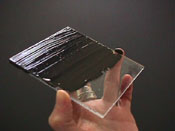
1. Cover plexi-glass plate with an even layer of tempera paint.
2. Draw in this layer with finger, brush, etc. or wipe away paint with
rag or sponge to produce negative space (places where paper will show).
3. Carefully press a sheet of paper down on the plate and rub gently with
the back of fingers. Do not press too hard and squash the image!
4. Lift paper when you have rubbed the whole image area. The print will
be a reverse of the original image. Notice if you did not spell your name
backwards on the plate, it will be spelt backwards on the paper.
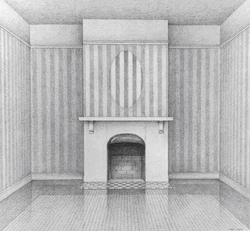
|
"The origin of The Empty Room was a house
on Waterford Bridge Road that was owned by a man who was blind. He
had no curtains (or, if he did, they were never drawn), no pictures
on the walls, no ornaments of any kind, and the mirror had been removed
from above the fireplace. As a child, I found this very spooky: a
house with nothing on the walls, seemingly empty, yet inhabited. -"
Christopher Pratt |
Learn about Symmetry through Contrast
Materials: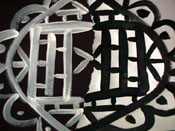
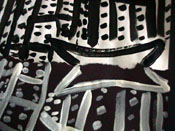 · Thin paintbrush
· Thin paintbrush
· Cup for water and a rag to wash brush
Directions:
1. Tear black paper in half and glue it over half of the white paper.
2. Paint a scene (it can be abstract or representative of something) by
making lines with the dark paint on the white paper. Continue the image
onto the black paper using thin lines with white paint. As the line shifts
from light to dark, the image in black will appear reflected in white.
WORD-SCAPES
Materials: 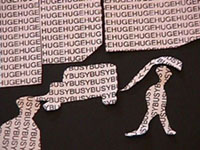
· A computer or typewriter to type one word repeatedly until you fill
the whole sheet
· Black construction paper
Directions:
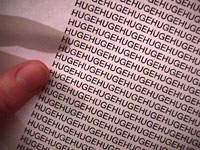
1. Type words bird or fat, busy, cloud,
calm.
2. Use scissors to cut a silhouette out of repeated text.
3. Glue cutout onto black construction paper.
Use more than one word and create a landscape or a portrait of someone you
know. Include the words hair, dress, chair, window,
sun, flowers … Try mismatching the words with shapes.
For instance, cut a fish shape out of a page of cat text. This
is a fun way to make poetic images.
Write a Picture Story
View Christopher's art work in the Gallery section and select images on
which to base a story.
For instance, view the following five images in this sequence:
These images could be the basis of a story about a treasure hunt that takes
place in an abandoned house. Find other connections!
return to You Try
return to Age 9-11
|




 Directions:
Directions:



 · Thin paintbrush
· Thin paintbrush


